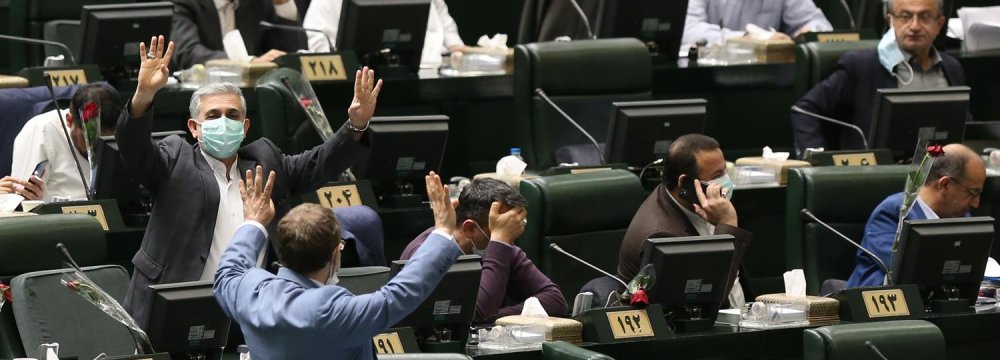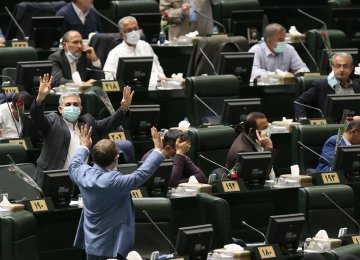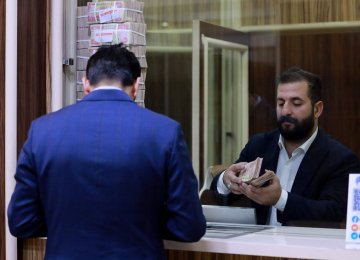The fate of heavy subsidies granted to import essential goods at the cheap rate of 42,000 rials per dollar remains elusive, as members of parliament delegated in a Sunday vote the responsibility for the removal or continuation of the controversial practice to the government.
The market rate of the dollar is about six times as much.
They, however, determined that should the government opt to put an end to the subsidy allocation as part of the upcoming fiscal year’s budget (March 2022-23), it has to spend the equivalent resources on distributing electronic coupons among consumers to compensate for the losses they may consequently suffer.
The coupon system was first used in Iran in the 1980s during the Iraq-imposed war.
From the Iranian year ending March 1985 to March 1989, the then government instituted a coupon system to ensure that everyone had equal access to essential food items.
Also known as necessity or basic goods, essential goods are products consumers will buy, regardless of changes in income levels, such as rice, vegetable oil, sugar and wheat.
Basic imports, which also include pharmaceuticals and medical equipment, are entitled to subsidized currency, provided from oil export.
While successive Iranian governments have subsidized food imports, cheap currency in its current format was first given after the steep rise in foreign exchange rates in the spring of 2018 soon after the United States abandoned the Iran nuclear deal and imposed tough economic sanctions.
Shortcomings
Flaws in the apparently ill-advised policy emerged in the first few months of its inception and the government under pressure was compelled to slash the list of goods eligible for subsidized currency.
In the current fiscal budget, the government was not allowed to pay more than $8 billion in subsidized currency for importing food and medicine. The Central Bank of Iran has said before that it has paid over and above the ceiling set in the budget.
Prominent economists, academia and socioeconomic experts hold the strong opinion that the forex subsidy policy never achieved its intended goal of supporting the downtrodden and greedy middlemen and cronies in the distribution chain benefited the most.
On many occasions, consumers of imported essential goods must buy their needs at prices that equal open market forex rates, thanks to the gross mismanagement, inefficient distribution system and the absence of viable government oversight.
In short, a significant portion of the cheap forex is pocketed by big importers and the distribution chain instead of end customers, which ostensibly means the millions of Iranians at the lower-end of the economic ladder.
It is often heard in Tehran’s politico-economic circles that in the past three years, billions in subsidized currency were given to selected companies to import food and medicine, yet some of these companies simply did not bring anything into the country.
It later turned out that some of the firms that took the scarce forex resources were shell companies. Few, if any, have paid for the thefts or faced the full force of the law.
Notably, a recent survey by the Statistics and Economic Analysis Center of Iran Chamber of Commerce, Industries, Mines and Agriculture indicated that mismanagement in subsidy allocations is one of the main problems facing local businesses.
“There is no supervision over the government’s method of paying subsidies to some goods such as food and pharmaceuticals. The subsidy is either exported via customs or smuggled out,” declared the survey, which was part of the Purchasing Managers’ Index report for the current Iranian year’s 10th month (Dec. 22-Jan. 20).
Inflationary Effect
Many economists and experts have warned about the inflationary effect of the removal of subsidies under the current circumstances.
Vahid Shaqaqi-Shahri, an economist and university professor, says that before the introduction of forex reform policy, certain preconditions must be met.
“First and foremost, the economy must see a period of stability. Secondly, the exchange rate and inflationary expectations should show a downtrend. The third condition is that the government should have adequate resources in local currency to manage this surgery; no shortage of local-source currency should be felt in this regard. The fourth condition is that the government should have an adequate sum of foreign exchange resources to control supply and demand in the forex market at any time,” he said.
“The fifth and final condition is that it must be determined whether the country has reached a nuclear agreement with the P4+1 group of countries and the United States. If these five conditions are met, the government can get rid of subsidized forex policy for the remaining seven items. Until these conditions are fulfilled, the government needs to continue the allocation of forex subsidies.”
In an article Shaqaqi-Shahri wrote for Ta’adol newspaper, he said, “In addition, after meeting these preconditions, the subsidy removal process should be carried out gradually over a specified period, meaning that the government should not go cold turkey and suddenly announce that the distribution of subsidized dollar has ended. The cessation of forex subsidy must happen over one to two years and under appropriate conditions.”








Add new comment
Read our comment policy before posting your viewpoints